Understanding Wood Types, Grain Patterns, Finishes, And More
Hardwood flooring brings warmth, elegance, and timeless appeal to any home. Whether your design style is contemporary, transitional, or traditional, the right flooring can elevate your interior and set the tone for the entire space. With so many options available, it’s important to select the type of hardwood that suits your aesthetic, lifestyle, and budget. Understanding the key differences in materials, finishes, and styles will help you make a choice that’s both beautiful and practical.

1. Types Of Hardwood Flooring
When it comes to hardwood flooring, one of the first and most important decisions you’ll make is choosing between solid wood and engineered wood. While both options offer the unmistakable appeal of real wood, they differ in structure, performance, and installation requirements. Your choice will depend on where the flooring will be used in your home, the environmental conditions of that space, and your long-term expectations for durability and maintenance.
Solid Wood
Solid hardwood flooring is crafted from a single, solid piece of wood, typically ¾ of an inch thick. This traditional option is valued for its longevity and natural character. One of the major benefits of solid wood is that it can be sanded and refinished multiple times over its lifespan, allowing homeowners to refresh the look or repair surface damage as needed.
However, solid wood is also more sensitive to changes in temperature and humidity. Because it can expand, contract, or even buckle when exposed to moisture, experts recommend installing it only on the main and upper floors of a home—never in basements or below-grade spaces. Solid hardwood is best installed over plywood subflooring using nails, staples, or glue—not over concrete, which can retain moisture and cause damage over time.
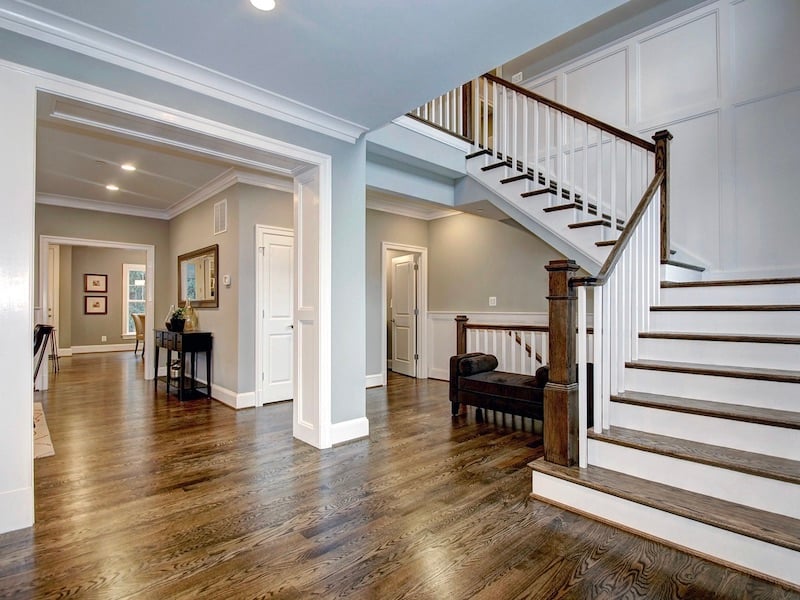
Engineered Wood
Engineered hardwood is a modern, versatile alternative that features a top layer of real hardwood veneer bonded to multiple layers of plywood or composite backing. This layered construction provides superior stability and resistance to environmental fluctuations, making engineered wood suitable for almost any area of the home, including basements and kitchens.
Another advantage of engineered wood is installation flexibility. It can be glued directly to a concrete slab or subfloor, floated over soundproofing material, or even installed over radiant heat systems. However, not all engineered flooring is created equal. Some budget options feature very thin veneer layers that can’t be sanded or refinished. For best results, choose a high-quality product with a thicker wear layer that allows for at least one refinishing if needed in the future.

2. Sustainable And Eco-Friendly Options
If environmental responsibility plays a role in your decision-making, there are several ways to ensure your hardwood flooring choices are eco-friendly. One of the most reliable indicators of sustainably sourced wood is certification from the Forest Stewardship Council (FSC). Products bearing the FSC certification meet these rigorous environmental and social standards, which are widely considered the benchmark for sustainability in the wood products industry. Alternatively, you can also look for certification from the Sustainable Forestry Initiative (SFI)—a North American program developed in partnership with the timber and paper industries that supports responsible forestry practices through conservation and community engagement.
In addition to certified new wood products, reclaimed wood is an excellent sustainable option. Reclaimed flooring is salvaged from older homes, barns, industrial buildings, and even fallen trees, giving new life to high-quality lumber that would otherwise go to waste. Not only does reclaimed wood reduce the demand for freshly harvested timber, but it also brings unique character, patina, and history to your space.
Another environmentally conscious alternative is bamboo flooring. Although not technically wood, bamboo is a rapidly renewable grass that matures in just a few years—far faster than traditional hardwood trees. Its durability and versatility make it a popular option for homeowners seeking a green flooring solution with a contemporary edge.
By selecting responsibly sourced or reclaimed materials, you can reduce your environmental impact without compromising on beauty or quality for your flooring.

3. Wood Species
Wood flooring is available in a wide variety of species, each with its own unique grain pattern, color tone, hardness, and character. Red oak and white oak are among the most popular choices for residential flooring—and for good reason. Both are durable, widely available, and accept stain evenly, making them incredibly versatile for a range of design styles. White oak tends to have a tighter grain and cooler undertones, while red oak has a more pronounced grain with warmer hues.
Beyond oak, other favored hardwood species include cherry, prized for its rich, reddish-brown color that deepens with age; maple, known for its smooth, subtle grain and light color; walnut, which offers deep, luxurious tones ideal for creating a sophisticated look; hickory, one of the hardest domestic woods, with bold grain variation that suits rustic or traditional spaces; and ash, a pale, resilient wood with a clean, modern appearance.
Each species not only affects the aesthetic of your space but also varies in hardness and how it reacts to wear and tear. If you live in a high-traffic household or have pets, for example, you may want to choose a harder wood like hickory or maple. Conversely, if your priority is visual warmth or elegance, walnut or cherry might be a better fit.
Ultimately, selecting the right wood species comes down to balancing the visual style you want to achieve with the practical needs of your home.
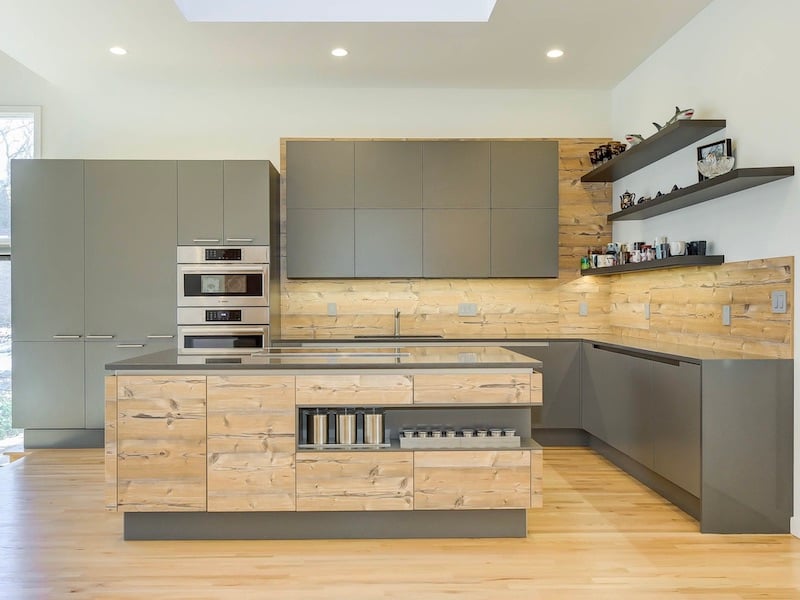
4. Grain Pattern
The appearance of wood grain in flooring is determined by how the log is cut during the milling process, resulting in four primary grain patterns—each with its own visual appeal and character. Plain-sawn wood, the most common cut, features a traditional, familiar look with signature "cathedral" or wavy grain patterns that flow across the face of the plank. Rift-sawn wood offers a clean, linear appearance with straight, vertical grain lines and minimal variation—ideal for creating a sleek, modern aesthetic. Quarter-sawn wood displays more irregular graining along with distinctive flecking or ray patterns, often found in species like oak, which adds visual texture and dimension. Live-sawn wood combines characteristics of all three cuts, resulting in wide planks with a unique mix of straight, wavy, and flecked grain patterns that showcase the natural beauty and diversity of the tree.
Each grain pattern contributes differently to the overall look and feel of a room. While some lend themselves to classic or rustic interiors, others are better suited for contemporary or minimalist designs. Since grain pattern is largely an aesthetic choice, it’s important to select one that complements your home’s style and the atmosphere you want to create.
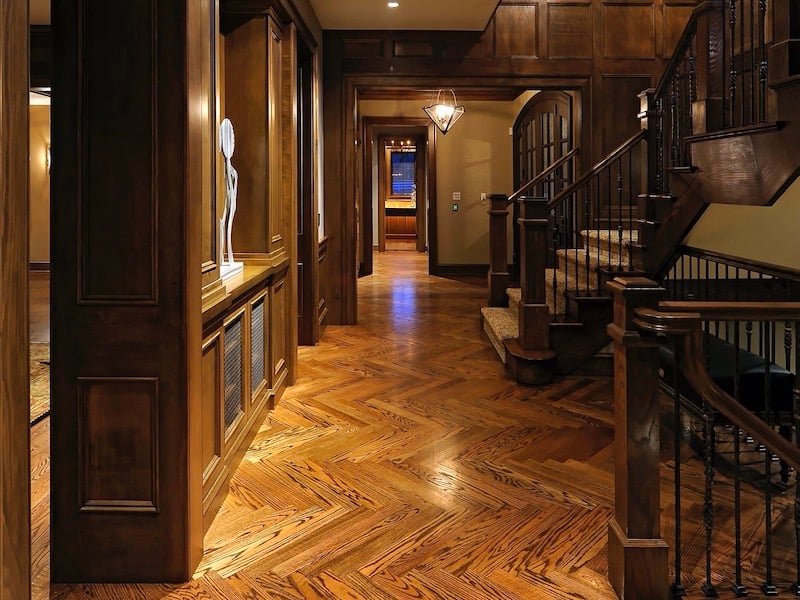
5. Plank Width
Standard hardwood flooring is typically composed of planks ranging from 2¼ inches to 3¼ inches in width. These narrower strips create a classic, uniform look that works well in most spaces. However, for a more customized or high-end aesthetic, you might consider opting for wider planks, which are available in widths of up to 10 inches or more. Wider boards allow the natural grain and definition of the wood to shine, making them a popular choice in luxury homes and open-concept spaces.
In addition to width, varying the length of the planks can add depth and interest, especially in larger rooms where longer boards help maintain visual balance and continuity. Keep in mind that wider and longer planks are typically more expensive, both in terms of material cost due to the increased waste factor and more precise installation requirements. That said, the result is a more expansive, elegant look that can significantly elevate the overall feel of your home—making the investment well worth considering.
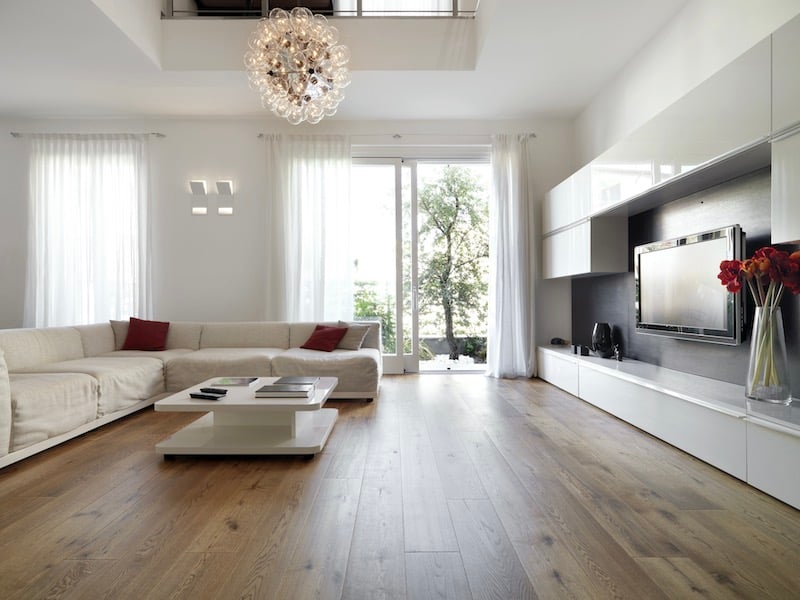
6. Stains And Finishes
Hardwood flooring—whether solid or engineered—is available in two primary forms: unfinished and pre-finished. With unfinished hardwood, the planks are installed first and then sanded, stained, and sealed on-site. This approach offers the highest level of customization, allowing you to select the exact stain color and sheen to match your design vision. It also creates a more seamless look, as the flooring is finished as a continuous surface. However, this process requires more time, creates dust during sanding, and may require the space to be vacated during finishing.
Pre-finished hardwood, by contrast, is treated in a controlled factory setting, where each plank is sanded, stained, and sealed before it ever reaches your home. This results in a highly durable, uniform finish and a faster, cleaner installation process. Since the color, texture, and sheen are determined ahead of time, what you see is exactly what you’ll get—making it an excellent choice if you're looking to streamline the installation or avoid the unpredictability of on-site finishing.
If you opt for unfinished flooring, you’ll need to select a finish type, with the two most common being polyurethane and oil. Polyurethane finishes create a hard, protective topcoat that resists wear and moisture, making it a low-maintenance option ideal for high-traffic areas. Oil finishes, while less resistant to scratches, offer a more natural, matte appearance. They tend to show wear more subtly and are easier to spot-repair, allowing the floor to develop a lived-in patina over time.
Beyond the type of finish, you can also choose from a variety of surface treatments to enhance the look and feel of the wood. Options include high-gloss for a sleek, polished look; satin or matte finishes for a more understated elegance; or hand-scraped and wire-brushed finishes that lend texture and a distressed, artisanal quality. With so many finishes and effects available, you can truly tailor your flooring to reflect the style, functionality, and atmosphere you want to achieve in your home.
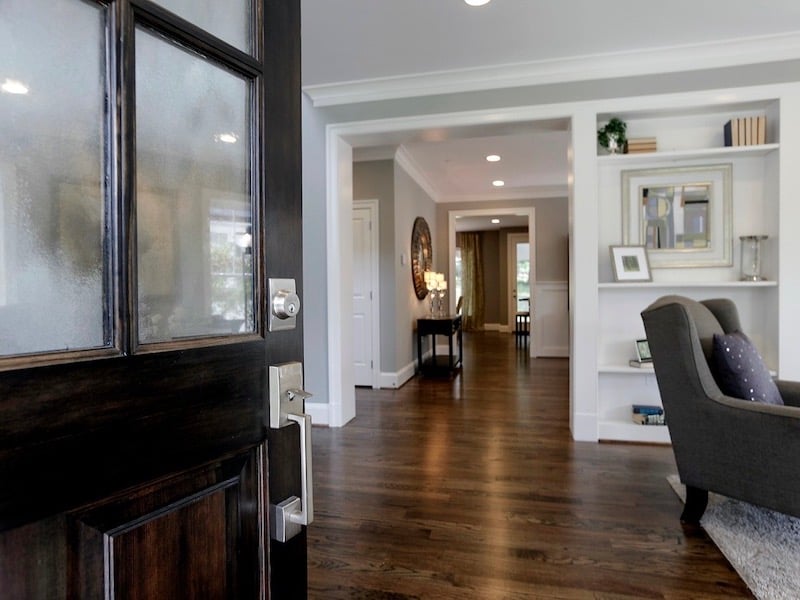
7. Volatile Organic Compounds (VOCs)
Volatile Organic Compounds (VOCs) are gases released from certain synthetic chemicals found in many household products, including adhesives, finishes, and sealants. When inhaled—especially in enclosed indoor spaces—these emissions can contribute to poor air quality and may lead to a range of health concerns, from mild respiratory irritation to more serious long-term effects. In the context of hardwood flooring, VOCs are most commonly found in the glues and finishes used during manufacturing and installation.
Some engineered wood products contain formaldehyde-based adhesives, which can continue to emit VOCs long after the flooring has been installed. Fortunately, many manufacturers now offer low-VOC or no-VOC options, including glues made from soy-based resins or other plant-derived binders, which are considered safer and more environmentally responsible.
Floor finishes are another potential source of VOC emissions. Oil-based polyurethane and certain other solvent-based finishes often contain petroleum-derived chemicals that off-gas over time. However, if you're installing pre-finished flooring, most of the off-gassing occurs at the factory—meaning your home will be exposed to far fewer airborne chemicals during and after installation.
For site-finished hardwood, where sanding, staining, and sealing take place in your home, you have more control over the finishing products you select. Consider using low-VOC, water-based polyurethane, or natural plant-based oils and waxes, which emit significantly fewer toxins and are better for both your health and the environment.
While researching and sourcing low-VOC flooring materials and finishes may require a bit more effort, doing so is a worthwhile investment in your indoor air quality and overall well-being, especially if you have children, pets, or family members with sensitivities. When in doubt, ask your homebuilder or flooring supplier about "green" certifications or environmentally conscious alternatives that align with your sustainability goals.
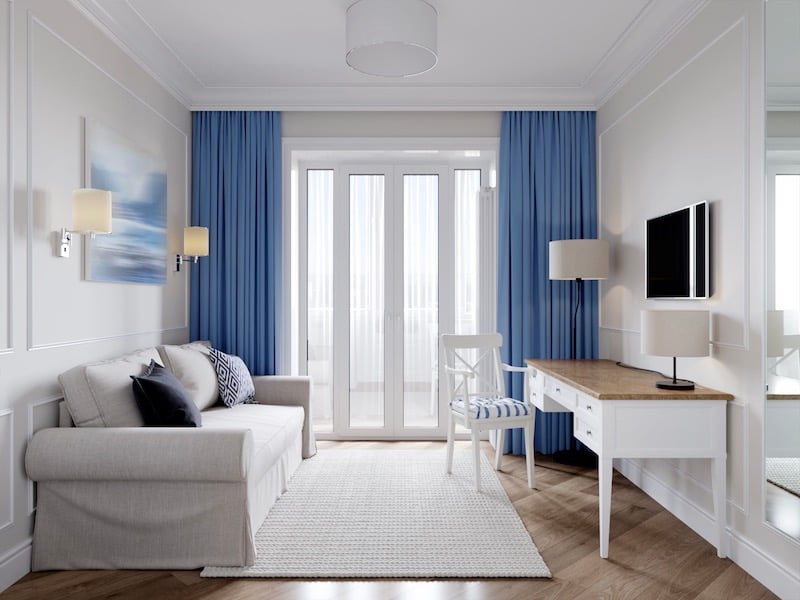
8. Cost Considerations
The cost of hardwood flooring can vary significantly depending on the specific materials and features you select, so it’s important to align your choices with your overall budget from the start. Understanding the key factors that influence pricing will help you make informed decisions without compromising the aesthetic or quality you’re aiming for.
In general, engineered hardwood tends to be more cost-effective than solid hardwood, both in terms of material and installation. Its layered construction uses less hardwood overall, which lowers production costs, and it can often be installed more quickly and easily.
Pre-finished flooring is typically less expensive than unfinished flooring, not only because the finishing process takes place at the factory but also because it reduces labor costs and installation time. With pre-finished wood, you avoid the added steps of sanding, staining, and sealing on-site—which also minimizes mess and disruption in your home.
Another major factor is the species of wood you choose. More common domestic woods like oak or maple are generally more affordable, while exotic or imported species such as Brazilian cherry or mahogany come at a premium due to their rarity and transportation costs.
Plank width also plays a role in overall cost. Wider planks are considered more luxurious and visually striking, but they are also more expensive to produce and install. The same applies to plank length—boards of varied or extra-long lengths create a more custom, upscale look but require more material, time, and precision to lay, which can increase labor charges.
Ultimately, the total cost of your hardwood flooring will reflect a combination of choices regarding material type, wood species, plank dimensions, finish, and installation method. By understanding how each element affects the bottom line, you can strike the right balance between beauty, performance, and affordability.
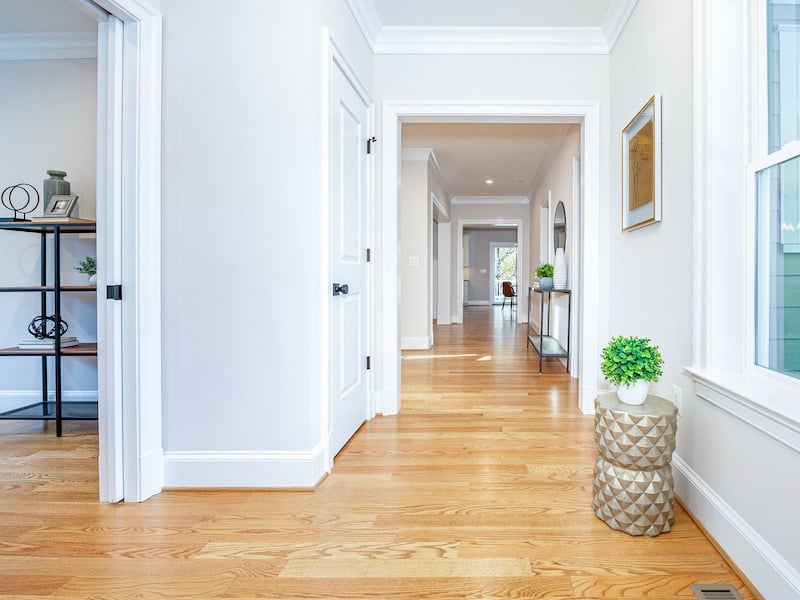
At Meridian Homes, we specialize in luxury remodeling and custom home building in the Washington, D.C. area. Our mission is to create exceptional residences that exceed expectations. Our highly personalized design process and careful management of every project have earned us a reputation over many years for outstanding client service and solid, beautiful craftsmanship. Contact us today to begin your custom home or remodeling project.




